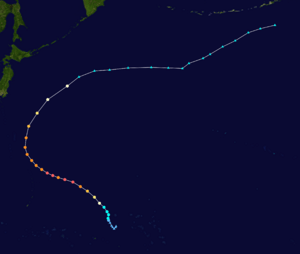Typhoon Lekima (2013) facts for kids
Typhoon Lekima was a super strong storm that happened in the Western Pacific in October 2013. It was a very unusual and powerful storm, reaching the highest level possible, called a Category 5 super typhoon.
At its strongest, Lekima had winds blowing at about 160 miles per hour. This made it one of the most intense storms of that year.
Contents
What is a Typhoon?
A typhoon is a type of very large and powerful storm that forms over warm ocean waters. You might also hear them called hurricanes or tropical cyclones, depending on where they happen in the world. Typhoons like Lekima form in the western Pacific Ocean.
How Do Typhoons Form?
Typhoons start when warm, moist air over the ocean rises. As this air rises, it cools and forms clouds and thunderstorms. More air rushes in to replace the rising air, and because the Earth spins, this new air starts to swirl. If the ocean water is warm enough (usually at least 80°F or 26.5°C) and other conditions are right, this swirling system can grow bigger and stronger, eventually becoming a typhoon.
Typhoon Categories Explained
Typhoons are given categories based on how fast their winds are. This helps people understand how dangerous a storm might be.
- A Category 1 storm has the lowest wind speeds.
- A Category 5 storm, like Lekima, is the strongest. It has very fast winds that can cause a lot of damage to buildings and trees.
Lekima's Journey and Strength
Typhoon Lekima began as a small area of low pressure. It quickly grew stronger as it moved across the warm waters of the Pacific. It became a tropical storm, then a typhoon, and finally a super typhoon.
When Lekima Was Strongest
Lekima reached its peak strength on October 22, 2013. At this point, it was a Category 5 super typhoon with winds of 160 miles per hour. This made it one of the most powerful storms ever recorded in that part of the world. Even though it was incredibly strong, Lekima stayed over the open ocean for most of its life. This meant it did not hit any major land areas directly when it was at its strongest.
What Happened After Its Peak?
After reaching its top strength, Typhoon Lekima started to weaken. It moved into cooler waters and faced conditions that made it lose power. Eventually, it changed into a different type of weather system, becoming what is called an "extratropical" storm. This means it lost its tropical storm features but could still bring strong winds and rain.
Impact of Typhoon Lekima
Because Typhoon Lekima mostly stayed over the open ocean, it did not cause widespread damage to cities or towns. However, it still affected shipping and fishing boats in the area. Strong waves and dangerous conditions were present where the storm passed. Even storms that don't hit land directly can be a danger to ships and people at sea.
Images for kids
See also
 In Spanish: Tifón Lekima (2013) para niños
In Spanish: Tifón Lekima (2013) para niños



